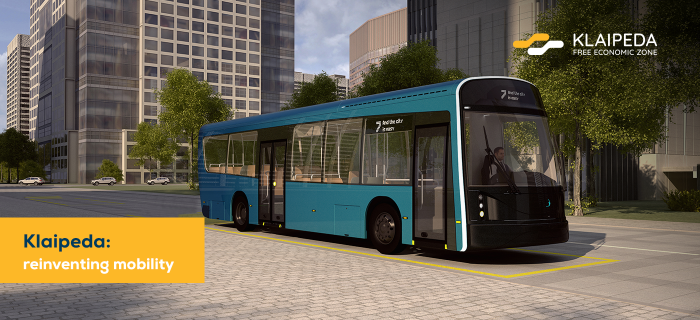News & Events
Watch our activity in one place
2019-08-19
Revolution in Klaipeda: electric buses, new pedestrian streets and bicycle garages

More people walking on foot, riding bicycles or choosing public transport, these are the goals Klaipeda sets for itself while defining its sustainable mobility goals for the next decade. The biggest plans in the short term are utilizing the Green wave, setting up modern bicycle garages, making the cobbled old town streets more comfortable and closing some streets to car traffic. Sustainable mobility is one of the tools to make living in the port city more comfortable, state experts, who are working hard to improve the health of the city and the people who live there by looking at examples from other European cities, 15min.lt reports.
The awaiting challenges have been put down on paper already. By 2030, the utilization of public transportation should grow from 30 to 35 percent, the popularity of bicycles – from 3 to 8 percent. At the same time, the share of people using cars should shrink from 36 to 24 percent, with a 2 percent growth of the pedestrian population too. According to the Klaipeda Municipality’s Head of the Urban Planning Unit, Mantė Černiūtė-Amšiejienė, the established goals may seem small percentage-wise but without taking action, the numbers would definitely swing in the opposite direction.
“The people who helped us create the vision for sustainable mobility helped us calculate what would happen without taking action, what would be the distribution of means of transport in the city. Without action now, the utilization of cars in the city would grow to 44 percent, public transport popularity would fall to 26 percent, just like the number of people walking on foot. If we don’t start working towards making the goals we set for ourselves a reality, we will have an opposite result,” says M. Černiūtė-Amšiejienė.
“The vision is aimed at improving the transportation situation in the city by aspiring to reduce the use of private means of transportation and encouraging the use of bicycles, public transport and just walking on foot.”
The goals have already started to be implemented by planning work up to 2020. Later, the plans necessary to be carried out to achieve the 2030 vision will be looked at as well. The Head of Urban Planning emphasizes and celebrates that this important strategic document was not of concern only to the municipality. Many different organizations participated while preparing it, associations of people with disabilities, the Klaipeda Free Economic Zone, representatives from the port, Klaipeda’s passenger transportation reps, the Cyclists’ Community. More than half of the Committee working on the sustainable mobility plans was made up of people outside the Municipality. This is how colorful and multifaceted ideas, which turned into a plan for sustainable mobility, were born. New ideas were borrowed from other countries. The city participated in a conference, where the ideas of sustainable mobility were shared by other countries, like Great Britain, Belgium, Poland, etc. In the Forum for Sustainable Mobility, which took place in April, Klaipeda was named among the cities with the most ambitious sustainable mobility goals for 2030. Klaipeda was even awarded as the one with the most ambitious vision for sustainable mobility.
Klaipeda already has eco-friendly buses, fueled by pressurized gas. Soon, we should see more of these buses in the city, with the first electric buses joining them on the streets in autumn. The latter ones are manufactured at the Klaipeda FEZ and deserve pride. According to Rimantas Mockus, the Head of Transportation at the Klaipeda Municipality, these buses are not cheap, they cost around 350 thousand EUR. You can buy two new gas-powered buses, however, the electric ones are more effective, you can charge their batteries in five minutes.
“This factory is in Klaipeda, we were at the presentation of these buses. The technical things are being done and we expect two of these buses to be seen in the street soon. We are looking to have more of them too,” says R. Mockus. “We will finish setting up the charging stations for these buses soon. Riding a bus like this is pure pleasure. They ride quietly, don’t damage the environment, have air conditioning. Finally, the idea that they were made in the city makes the hearts of our citizens grow fond.”
